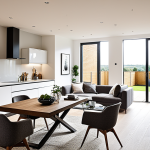Practical Adaptations for Different UK Pets
Adapting a UK home for pets requires tailored modifications based on the specific needs of dogs, cats, small mammals, birds, and reptiles. For example, dogs benefit from secure outdoor spaces to safely exercise, while cats need vertical areas like shelves or cat trees to scratch and rest. Small mammals such as rabbits or guinea pigs require sturdy cages away from drafts and direct sunlight to ensure comfort and safety.
In multi-pet households, safety becomes paramount. To avoid conflicts, designate separate feeding zones and resting areas. This prevents resource guarding and stress. Additionally, pet-proofing throughout the home is crucial—ensuring wires are out of reach, toxic plants or cleaners are inaccessible, and secure enclosures prevent escape or injury.
Topic to read : Why Do Certain UK Pets Have Different Health Needs?
Room-specific adaptations enhance overall wellbeing. Kitchens should be off-limits or thoroughly pet-proofed to prevent accidental ingestion of harmful foods. Living rooms and bedrooms can be equipped with washable covers and designated pet zones to protect furniture and maintain hygiene. These thoughtful modifications create a safe, comfortable environment tailored to the varied needs of UK pets, improving their health and happiness.
Space Planning and Pet-Specific Zones
Creating home zoning for pets is essential to address the varying needs of dogs, cats, birds, and small mammals. Dogs often require spacious, secure areas for exercise and play, ideally connected to safe outdoor spaces. Cats benefit from vertical climbing towers and secluded nooks, supporting their natural curiosity while providing refuges. Birds need dedicated aviaries or cages placed in quiet areas but with natural light to promote wellbeing. Small mammals and reptiles require climate-controlled zones to maintain proper temperature and humidity.
Have you seen this : How Can You Create a Welcoming Environment for Cats in Your UK Home?
Maximising both communal and private spaces supports pets’ mental health. Dogs may enjoy shared family rooms, while more sensitive animals such as rabbits or reptiles thrive in quiet, low-traffic rooms. Integrating zones that allow visual but limited physical contact can reduce stress in multi-pet households.
Safe outdoor access is a priority. Designing enclosed gardens or patios protects animals from escape and predators. Indoor exercise areas equipped with pet-friendly flooring and enrichment toys ensure pets stay active during adverse weather. Thoughtful pet-friendly spaces encourage natural behaviours, improving overall comfort and happiness in the home.
Pet-Proofing and Hygiene Solutions
Ensuring effective pet-proofing in UK homes involves selecting durable materials and furniture that withstanding wear from claws, chewing, or scratching. Consider using washable fabrics and scratch-resistant surfaces to protect upholstery and floors. Managing odours is key for pet hygiene; frequent cleaning with pet-safe products can reduce smells without harming animals. Enzymatic cleaners help break down organic stains, maintaining a fresh environment.
In multi-pet households, distinct hygiene routines prevent cross-contamination. Regularly sanitise feeding areas and litter boxes, and rotate toys and bedding to curb bacteria build-up. Proper pet-proofing extends to securing electrical cords, removing toxic plants, and locking cabinets containing chemicals or medications, safeguarding pets from accidental ingestion or injury.
Adopting practical cleaning solutions, such as vacuum cleaners designed for pet hair and enclosed litter systems, further supports hygiene. This approach not only upholds a cleaner home but also promotes the health and comfort of all pets, emphasizing the importance of tailored pet-proofing strategies in maintaining safety and wellbeing in UK families with diverse animals.
Practical Adaptations for Different UK Pets
Creating effective UK pet home adaptations means addressing species-specific needs with both safety and comfort in mind. For dogs, secure fencing and durable flooring allow for vigorous play without risk. Cats benefit from vertical climbing structures and protected windowsills that satisfy their instincts safely indoors.
Small mammals like rabbits and guinea pigs require cages placed away from direct sunlight and draughts, promoting a stable environment essential for their wellbeing. Birds need appropriately sized aviaries with natural light but shielded from sudden temperature changes, while reptiles demand controlled humidity and heat sources that mimic their natural habitats.
In multi-pet households, safety is critical. Establishing clear boundaries—such as separate feeding stations and individual resting spots—prevents stress and potential conflicts. Pet-proofing here extends beyond securing wires and toxic items; it involves constant monitoring to ensure all animals coexist peacefully.
Room-specific adaptations improve comfort further. Kitchens, often hazardous, must be off-limits or pet-proofed, while living areas can include washable covers and designated zones to reduce wear and ensure hygiene. These strategic modifications uphold pet-proofing standards and prioritize safety for pets, enhancing overall quality of life.
Practical Adaptations for Different UK Pets
Effective UK pet home adaptations require tailoring environments to individual species while prioritising pet-proofing and safety for pets. Dogs need secure, non-slip flooring and gated outdoor areas to prevent escapes and injuries. For cats, vertical spaces like shelves or cat trees encourage natural climbing behaviours and offer safe retreats, reducing stress. Small mammals such as rabbits and guinea pigs benefit from cages placed in draft-free rooms with indirect sunlight, ensuring temperature stability and comfort. Birds require sturdy aviaries with adequate ventilation and protection from sudden temperature swings, maintaining their health. Reptiles demand carefully controlled humidity and temperature via specialist heating and lighting equipment that mimic their natural climates.
In households with multiple pets, clear boundaries are vital to avoid conflicts. Separate feeding stations and resting areas prevent resource guarding and allow each animal a safe space. Additionally, strict pet-proofing measures—securing electrical cords, removing toxic plants, and locking hazardous materials—are essential to minimise risks. Room-specific adaptations further support wellbeing: kitchens should be strictly off-limits or made secure to avoid exposure to dangerous foods or chemicals, while living areas can incorporate washable covers and designated pet zones to maintain hygiene and comfort. These strategies combine to create a safe, enriched environment tailored to the diverse needs of UK pets.






